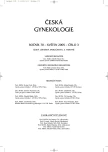Nalbuphine in Obstetrical Analgesia
Authors:
B. Vavřinková; L. Oborná; T. Binder; J. Horák
Authors‘ workplace:
Gynekologicko-porodnická klinika 2. LF UK a FN Motol, Praha, přednosta doc. MUDr. L. Rob, CSc.
Published in:
Ceska Gynekol 2005; 70(3): 180-183
Category:
Original Article
Overview
Objective:
Comparison between particular methods of obstetrics analgesia, their analgetic efects and influence on the progress of delivery and postpartum adaptation of fetus.
Design of the study:
Prospective study.
Setting:
The Department of Gynecology and Obstetrics of the Teaching Hospital and the 2nd Medical Faculty of the Charles University in Prague.
Methods:
A prospective study of 92 patients who received intravenous infusion nalbuphine (28 women) or epidural analgesia (31 women) or pethidin (33 women). Assessment of maternal analgesia, satisaction was carried out. Apgar scores and resuscitative measures required for the neonate were note at delivery. Results: The best analgesic effect was in the group with using peridural analgesia, where max. score was 3. The highest value was in the group of women who received pethidin. The most significant decrease of score after application of analgesia was in group with epidural analgesia, the least decrease of score was in the group with pethidin. The Apgar score at 1. minute was the lowest in the group with epidural analgesia, the highest score was in the group with nalbuphine.
Conclusion:
The mixed agonist/antagonist narcotic analgesic like nalbuphine have the place in clinical practice. The obstetric analgesia is very common in obstetrics practice. The epidural analgesia is very popular but not always accessible. Nalbuphine is the option which is effective in analgesia and have minimal side-effects.
Key words:
analgesia, pain, delivery, opiate
Labels
Paediatric gynaecology Gynaecology and obstetrics Reproduction medicineArticle was published in
Czech Gynaecology

2005 Issue 3
Most read in this issue
- Nalbuphine in Obstetrical Analgesia
- Premature Separation of the Placenta – Etiology and Risk Factors
- „Mixed“ and „Miscellaneous“ Vulvovaginitis: Diagnostics and Therapy of Vaginal Administration of Nystatin and Nifuratel
- Metastasing and Relapsing „Low Grade“ Adenosquamous Metaplastic Breast Cancer – is There a Really Indolent Lesion? A Description of Three Cases and Review of Literature
